A football coach haunted by the deaths of 28 former players fights to save the next generation
This article was produced as a project for the Dennis A. Hunt Fund for Health Journalism, a program of the USC Annenberg Center for Health Journalism.
Other stories in the series include:
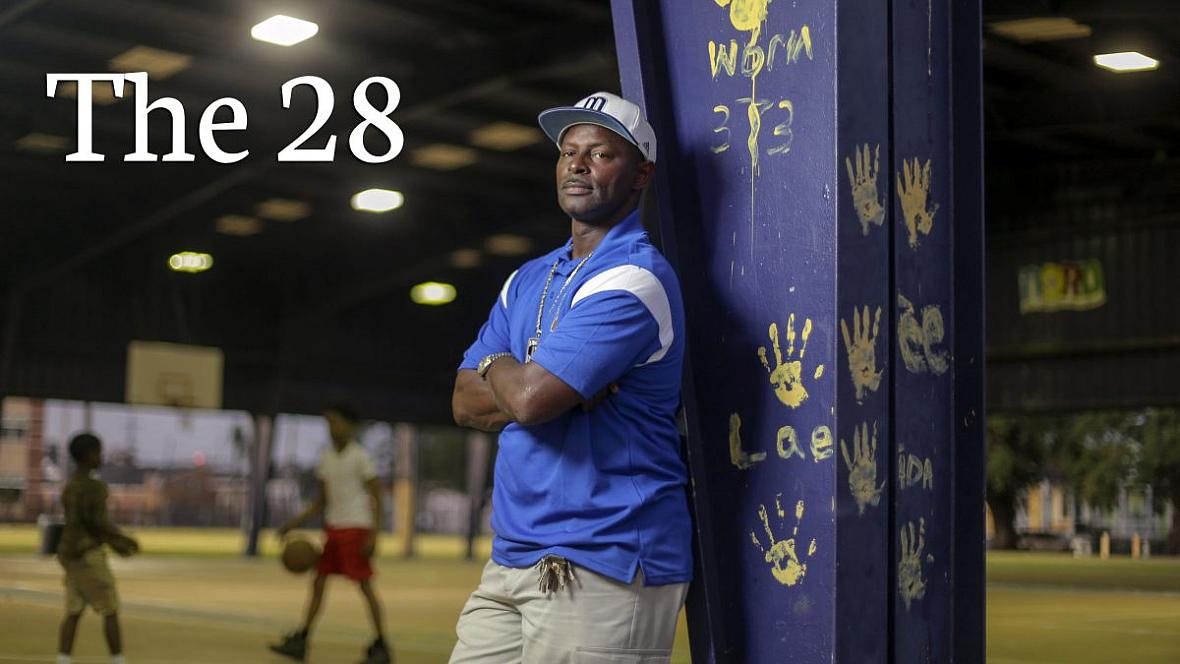
Jerome Temple pulls a tattered piece of paper out of a black binder and lays it on a table next to a yellow water cooler. There are 28 names scrawled on the single-ruled page. At the top, Temple has written, “Football players deceased.”
It’s shortly after 6 p.m. on a Tuesday in October. The sky is streaked with red and purple as the sun sets over A.L. Davis Park in New Orleans’ Central City. Temple, 52 – known to most as DJ Jubilee, an innovator of New Orleans’ bounce music – watches his beloved Panthers practice, one of 85 teams in the New Orleans Recreation Department’s youth football league.
Temple began coaching the team in 1997, when it was based in Annunciation Park in the old St. Thomas projects. The Panthers moved to A.L. Davis in 2001, after the city razed the infamous public housing development on the outskirts of the Lower Garden District.
Temple, who stopped coaching in 2016 and now works as a site facilitator for NORD, speaks with pride about his tenure with the team, during which he won eight league titles. It’s that tattered piece of paper, however, marked with the names of the dead, that Temple carries wherever he goes. It serves as a reminder that, at times, he lost far more than he won.
Twenty-eight former Panthers were killed in a 14-year span. The list begins with 17-year-old Joseph Singer in March 2003 and ends, for the moment, with 31-year-old Calvin Curtis in July 2017 – one of three former players shot to death last year.
Singer and Curtis were teammates on the 1998 Panthers, which, like all of Temple’s teams, consisted of 13- and 14-year-old boys from some of the city’s most dangerous neighborhoods.
“I started jotting their names down after the storm,” Temple says, referring to Hurricane Katrina. “My manager would call and say, ‘Jube, you hear about your ballplayer who got killed?’ I’d say, ‘Who?’ He’d say, ‘Tyrone.’ He’d say, ‘Jerry.’ He’d say, ‘Lil’ Nathan.’ All of a sudden, I end up with a list of 10 of them, then 14, then 16, 17, 18. I’m like, something ain’t right here.”
Temple has always been a true believer in football, that its regimented, team-oriented framework can instill discipline in troubled children, provide an outlet to release their anger, a family of teammates to provide a few hours of respite from whatever pain has seeped into their off-the-field lives.
Assistant coach Claude Dixon gives instructions to members of the A.L. Davis Park Panthers during practice.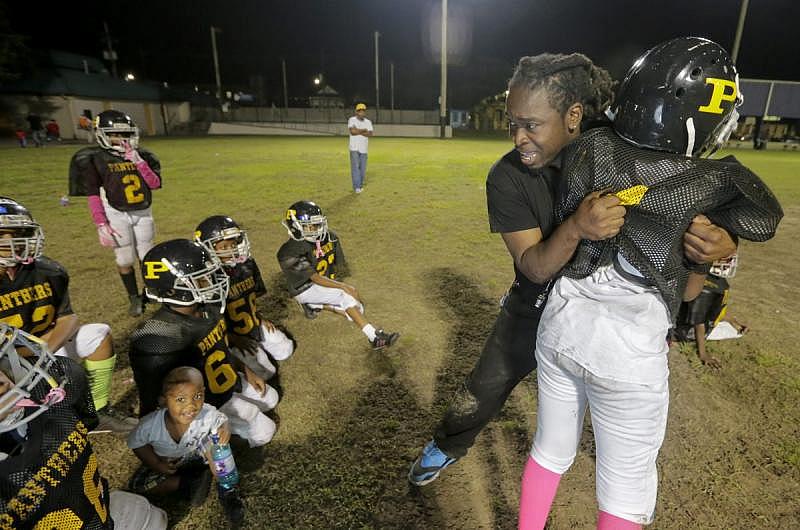
For nearly two decades, this is how Temple has tried to help the traumatized youth of New Orleans, children whose mental health has been damaged by the violence that surrounds their lives. Research shows this type of trauma often prompts them to behave and lash out in risky and dangerous ways. Central City, where the Panthers practice, had the highest number of nonfatal shootings in 2016 and the third highest number of murders among New Orleans neighborhoods, according to the most recent full-year data of crime by neighborhood compiled by NOPD.
At times, Temple’s sports-driven approach has been successful. Many former players have gone on to live productive lives, crediting the support he gave and the lessons he taught them. Temple is proud of these victories, but often feels as if he is fighting without the help he needs to make a lasting difference. State funding for mental health care, for example, was cut last year by nearly $50 million, including a wide range of programs targeting children suffering from trauma.
Temple is not one to give up, but it gets harder each year, he says. He knows that if something more isn’t done to help these children, it’s inevitable that he will be forced to add more names to his list.
“You only have a small window when you can reach them,” Temple says. “All the elements out there is waiting for them, the drugs and guns and killing. All that negativity. It gets scary.”
“What is you doing?” Claude Dixon yells in exasperation, as the Panthers’ 9-year-old quarterback takes the snap, drops back three steps, then pitches the ball to an empty spot on the field. The team has been practicing the same play for nearly an hour. The results have been less than promising and assistant coach Dixon is losing his patience.
Jerome Temple looks on as players of the A.L. Davis Park Panthers gather in the field house after practice.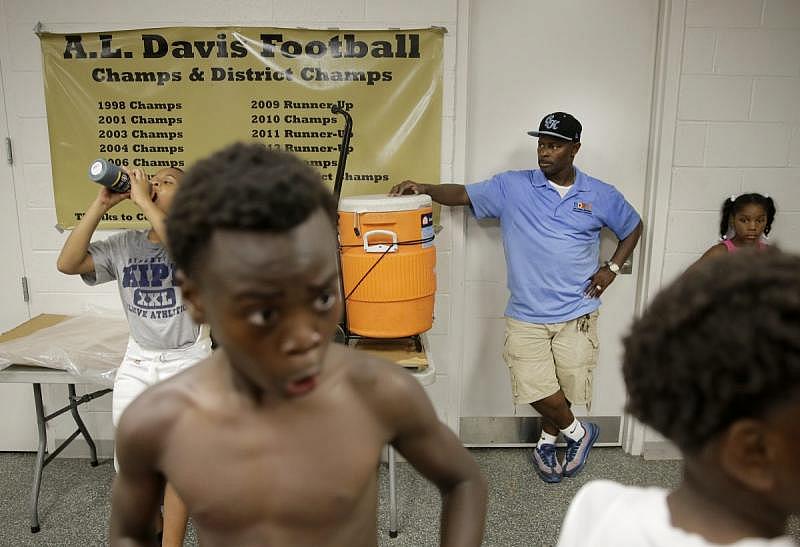
“If y’all don’t get it, y’all gonna look the exact same way as you did in the last game!” Dixon shouts, referring to the team’s first game of the season in September. The Panthers lost by 34 points.
Temple stands on the sideline, watching his protégé attempt to instill some semblance of order among the Panthers’ current roster of 9- and 10-year-old boys. Dixon’s efforts are not always successful, which is not surprising. They are, after all, just children. But immaturity alone does not explain away their lack of focus.
Many of the Panthers have already experienced horrific trauma. One player was 3 when he and his older brother found their mother shot dead on the kitchen floor. Another, at the age of 5, saw a woman shoot a man in the parking lot of a Church’s Chicken. Both players, according to their families, haven’t been the same since, suffering from stress, anger, hyperactivity and depression.
Two other players on the team are related to Telly Hankton, the notorious New Orleans gang leader serving two life sentences for murder. Another player is a cousin of Briana Allen, the 5-year-old girl shot to death at a Central City birthday party five years ago.
Scientific research has shown that early exposure to traumatic events can alter the way children’s brains work, increasing their aggression and impulsiveness, and decreasing their ability to retain information, develop empathy and build self-esteem. The resulting behavior, if unrecognized and untreated, can lead to expulsion from school and juvenile incarceration, perpetuating the cycle of violence and poverty.
Temple looks at this newly formed team of 25 boys, their small frames clad in oversized pads and helmets. Some of them, he says, remind him of his previous players whose names are forever imprinted on that mournful list. He’s seen the same story play out year after year, decade after decade, and knows that if these children are to be saved, it needs to happen now, before they get older and harder to reach.
“When you’re 12 you see it, when you’re 13 you think about it, when you’re 14, you become it,” Temple says, the “it” being the street life. “By that point, they finished playing football. All they know is weed, drugs and fighting.”
Therapy has proven effective in helping boys and girls overcome trauma. In poorer neighborhoods like Central City, however, access can be difficult. There are only a handful of reputable providers scattered across New Orleans, according to the Louisiana Center for Children’s Rights, and their resources are limited due to low Medicaid reimbursements and chronic budget cuts at the state level. This leaves many families seeking alternatives such as recreational sports, which is where Temple found solace and stability as a child growing up in the St. Thomas projects.
Like many of the players he coached, Temple was surrounded by drug dealing and murder as a youth. Gangs were everywhere, he says, ticking off their names: the Driveway boys, the Shine Street boys, the Palm Tree boys and the St. Mary boys.
“All my years in the St. Thomas, we lost (a lot of people) to murder or overdoses, and the majority were killed before 25,” he says.
Eventually, that violence reached Temple’s family. All four of his brothers have served time in prison for drug-related offenses, with one confined to a wheelchair after being shot in the back. Temple says that negativity had the opposite effect on him, steering him toward more positive endeavors.
As an adolescent, he threw himself into sports, playing football in the dusty lots of the St. Thomas, outfitted in hand-me-down jerseys, “raggedy” tennis shoes and “old-time” facemasks and neck rolls. He went on to graduate from Grambling State University, after which he scored local and national acclaim as DJ Jubilee.
Chris Robinson, 32, a former star wide receiver on the Panthers youth football team, currently works as a hotel bellman with hopes of starting a mentoring program for troubled youth. Robinson's cousin, Drontreal Beal, also a former member of the Panthers, was shot to death in 2016.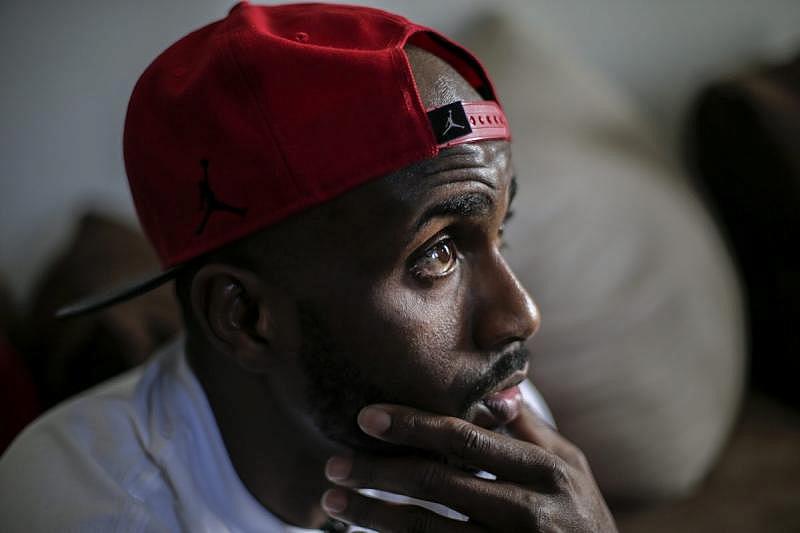
But Temple always returned to the St. Thomas, often times to recruit players for the Panthers youth football team – to give to others the same escape from violence he enjoyed when he was growing up.
Sitting in his office in A.L. Davis Park, Temple takes out a photo of the 1998 championship team. Three players from this group are dead, but he doesn’t focus on them. Instead, he points to a single face amid the crowded frame of 16 Panthers, a teenage boy wearing number 23, staring back intently at the camera.
“That’s ‘Air Chris,'” Temple says, referring to Chris Robinson, star receiver of Temple’s first championship team two decades ago.
Robinson was 13 when he played in the championship game, around the same time he saw his first dead body. It was a man, lying under a tree near Adele and St. Thomas streets. Robinson, now 32, says seeing that body made him feel constantly on edge, realizing that his home, the former St. Thomas housing development, was unsafe, a place where death could manifest at any moment.
“People selling drugs, that’s what I seen, night in and night out. Sex in the hallways, guns you could touch. It was tough growing up,” he says. “I used football and basketball, those were my outlets to stay away.”
There is only so much, however, that football or a dedicated coach can do. Three people on Robinson’s championship team were later killed, including his cousin who was shot to death in the hallway of a New Orleans East motel nearly two years ago. Robinson said his cousin’s name was Drontreal Beal, though the coroner identified him as Drontreal Eleby.
The problem, Robinson says, is that Temple had access to his players for just a few hours a night and only during football season. After that, those boys had to go back to whatever was waiting for them in the courtyards, hallways and dilapidated apartments they called home.
Robinson credits his own survival to strict parents and the positive example set by Temple. He currently works as a bellman at the Hilton New Orleans Riverside hotel, is set to graduate from Delgado Community College next year with a degree in business and management, and is working to establish a mentorship program based around sports called, Dreams to Reality.
Jerome Temple holds a list of 28 former players on the Panthers youth football team who were killed over a 14-year-span.
Temple considers his former star wide receiver to be one of his greatest success stories. To prove his point, he takes out a team photo from 1999, the next season after Robinson’s championship. There are 41 kids between the ages of 11 and 14 dressed in the Panthers’ signature black and yellow jersey. Temple places his finger on the picture, moving from player to player, describing the fate of each young man.
“He just got killed. He’s in a wheelchair paralyzed. I don’t know where he’s at. He’s dead. He shot him. Ray back in jail. Sean got life in jail. He works at Commander’s Palace. Dig’em, he’s in jail right now. …
“I got a whole football team in Angola,” he says of the Louisiana State Penitentiary.
Temple believes that former players like Robinson can serve as role models, that the A.L. Davis Park Panthers can provide a glimmer of hope. But he knows it’s just a glimmer. He knows the problems facing many of these children run far too deep to be solved by tackling drills and championship banners.
“I try not to talk about this so much,” Temple says, looking at the 1999 photo, the faces of all those players from nearly 20 year ago staring back at him. “Our successes outweigh all this. But death is so big.”
It’s just past 7:30 p.m. at A.L. Davis Park in October and practice is almost over for the Panthers. As coaches Claude Dixon and Edgarson Shawn Scott run the team through a few final plays, three boys watch from outside the fence.
One of the boys, a husky kid, walks with a slow, determined gait through the entrance and up to the team’s water cooler. Temple motions that it’s OK for him to have a drink. The boy dips his head under the spigot, presses the button, splashes some water in his mouth, then saunters back to his friends on the other side of the fence.
“That’s one of my troublemakers,” Temple says of the 16-year-old. “He used to play for me. He quit for no reason. He thinks he’s a big baller now. Somebody’s gonna knock his a– out.”
Temple watches as the boy walks away, down Third Street towards South Claiborne Avenue, with the two other boys who are smaller, skinnier and who appear a few years younger.
“They all smoke weed. They high right now,” Temple says. The smallest of the three, a 15-year-old, also played for the Panthers.
A month after that encounter, the 16-year-old and the 15-year-old were arrested on a long list of charges including possession of a stolen vehicle and stolen property. The 15-year-old asked his attorney to call his old coach. Temple visited with the boy, his feet in shackles, at the Youth Study Center jail, then posted his $2,700 bail. The judge, however, refused to release the child until a hold on separate charges from another court was resolved.
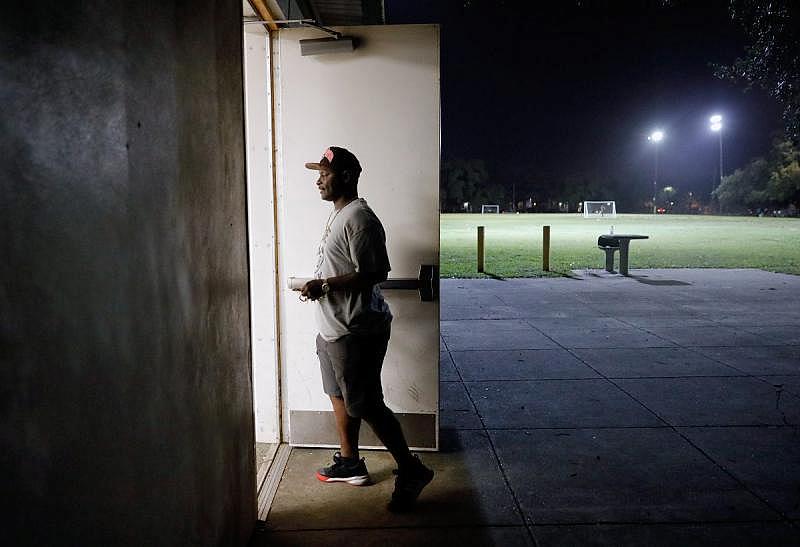
When the judge announced his decision in court, Temple says his former player burst into tears.
“I explained to the judge how he was a good kid and I would try to save him, I would try to let him be with me for a while so far as community service, try to give him counseling,” Temple recalled later. “The judge was listening and heard my story about how many players I lost since 2003. He heard the passion in my voice, but he wouldn’t let him go.”
Back at A.L. Davis Park, as Temple watches the Panthers practice, he says he is proud of his accomplishments, but that pride is tempered by worry. He knows the odds are stacked against them.
Out of these 25 players, his experience tells him, at least half might be killed or sent to prison. But it doesn’t have to be this way, he says.
“My main thing is, we know the end result to everything that’s going on. We know who’s going to be killed, who’s going to do the killing. It’s just a matter of time,” he says. “If we don’t support these kids, do everything we can, we know what’s going to happen. So why do we let it?”
The coaches blow their whistles. Practice is over. The Panthers gather as a group in the middle of the field and pray the Our Father. “Lead us not into temptation, but deliver us from evil. Amen.”
They run into the clubhouse to take off their uniforms and equipment. Temple follows them inside, keeping watch.


